Larch
Larches are conifers in the genus Larix, of the family Pinaceae (subfamily Laricoideae). Growing from 20 to 45 metres (65 to 150 feet) tall,[1] they are native to much of the cooler temperate northern hemisphere, on lowlands in the north and high on mountains further south. Larches are among the dominant plants in the boreal forests of Siberia and Canada. Although they are conifers, larches are deciduous trees that lose their needles in the autumn.
| Larch | |
|---|---|
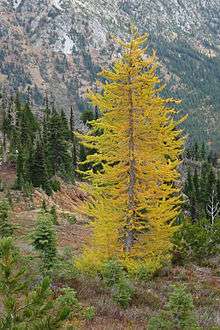 | |
| Larix lyallii in autumn | |
| Scientific classification | |
| Kingdom: | Plantae |
| Clade: | Tracheophytes |
| Division: | Pinophyta |
| Class: | Pinopsida |
| Order: | Pinales |
| Family: | Pinaceae |
| Subfamily: | Laricoideae |
| Genus: | Larix Mill. |
| Type species | |
| Larix decidua | |
| Species | |
|
About 10–11; see text | |
Description and distribution
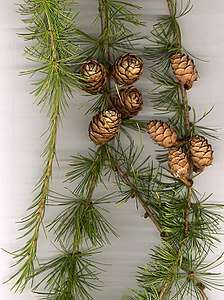
The tallest species, Larix occidentalis, can reach 50 to 60 m (165 to 195 ft). The larch's tree crown is sparse and the branches are brought horizontal to the stem, even if some species have them characteristically pendulous. Larch shoots are dimorphic, with leaves borne singly on long shoots typically 10 to 50 cm (4 to 20 in) long[2]:47 and bearing several buds, and in dense clusters of 20–50 needles on short shoots[2] only 1–2 mm (1⁄32–3⁄32 in) long with only a single bud. The leaves (light green) are needle-like, 2 to 5 cm (3⁄4 to 2 in) long, slender (under 1 cm or 1⁄2 in wide). Larches are among the few deciduous conifers, which are usually evergreen. Other deciduous conifers include the golden larch Pseudolarix amabilis, the dawn redwood Metasequoia glyptostroboides, the Chinese swamp cypress Glyptostrobus pensilis and the bald cypresses in the genus Taxodium. The male flowers (small cones) are orange-yellowish and fall after pollination. The female flowers (or cones) of larches are erect, small, 1–9 cm (1⁄2–3 1⁄2 in) long, green or purple, brown in ripening and lignify (called now strobilus) 5–8 months after pollination; in about half the species the bract scales are long and visible, and in the others, short and hidden between the seed scales. Those native to northern regions have small cones (1–3 cm or 1⁄2–1 in) with short bracts, with more southerly species tending to have longer cones (3–9 cm or 1 1⁄4–3 1⁄2 in), often with exserted bracts, with the longest cones and bracts produced by the southernmost species, in the Himalayas. The seeds are winged. The larches are streamlined trees, the root system are broad and deep and the bark is finely cracked and wrinkled in irregular plaques. The wood is bicolor, with salmon pink heartwood and yellowish white sapwood. The chromosome number is 2n = 24, similar to that of most of the other trees of the family Pinaceae.
The genus Larix is present in all the temperate-cold zones of the northern hemisphere, from North America to northern Siberia passing through Europe, mountainous China and Japan. The larches are important forest trees of Russia, Central Europe, United States and Canada. They require a cool and fairly humid climate and for this reason they are found in the mountains of the temperate zones, while in the northernmost boreal zones ones they are also found in the plain. At gen. Larix belong to the trees that go further north than all, reaching in the North America and Siberia the tundra and polar ice. The larches are pioneer species not very demanding towards the soil and they are very long-lived trees. They live in pure or mixed forests together with other conifers or more rarely broad-leaved trees.
Species and taxonomy
In the past, the cone bract length was often used to divide the larches into two sections (sect. Larix with short bracts, and sect. Multiserialis with long bracts), but genetic evidence[3] does not support this division, pointing instead to a genetic divide between Old World and New World species, with the cone and bract size being merely adaptations to climatic conditions. More recent genetic studies have proposed three groups within the genus, with a primary division into North American and Eurasian species, and a secondary division of the Eurasian into northern short-bracted species and southern long-bracted species;[4] there is some dispute over the position of Larix sibirica, a short-bracted species which is placed in the short-bracted group by some of the studies and the long-bracted group by others. The genus Larix belongs to the subfamily Laricoideae, which also includes the genera Pseudotsuga and Cathaya.
There are eleven (or ten, see L. czekanowskii) accepted species of larch subdivided on the basis of the most recent phylogenetic investigations:[5]
North American species
.jpg)
- Larix laricina (Du Roi) K. Koch – Tamarack or American larch. Parts of Alaska and throughout Canada and the northern United States from the eastern Rocky Mountains to the Atlantic shore.
- Larix lyallii Parl. – Subalpine larch. Mountains of northwest United States and southwest Canada, at very high altitude.
- Larix occidentalis Nutt. – Western larch. Mountains of northwest United States and southwest Canada, at lower altitudes (Pacific Northwest).
Eurasian species
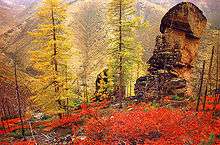
Northern Eurasian species with short bracts
- Larix decidua Mill. (syn. L. europaea D.C.) – European larch. Mountains of central Europe.
- Larix sibirica Ledeb. – Siberian larch. Plains of western Siberia.
- Larix gmelinii (Rupr.) Kuzen. (syn. L. dahurica) – Dahurian larch. Plains of central and eastern Siberia.
- Larix kaempferi (Lamb.) Carr. (syn. L. leptolepis) – Japanese larch. Mountains of central Japan.
- Larix x czekanowskii Szafer – Uncertain. Its origin could be hybrid.
Southern Euroasiatic species with long bracts

- Larix potaninii Batalin – Chinese larch. Mountains of southwestern China (Sichuan, northern Yunnan).
- Larix mastersiana Rehder & E.H.Wilson – Masters' larch. Mountains of western China.
- Larix griffithii Hook.f. (syn. L. griffithiana) – Himalayan larch. Mountains of the eastern Himalayas.
Most if not all of the species can be hybridised in cultivation. Currently-accepted hybrids are:[5]
- Larix × lubarskii Sukaczev
- Larix × maritima Sukaczev
- Larix × polonica Racib.
A well-known hybrid, the Dunkeld larch Larix × marschlinsii (syn. L. × eurolepis, an illegitimate name), which arose more or less simultaneously in Switzerland and Scotland when L. decidua and L. kaempferi hybridised when planted together, is still treated as unresolved.[5] Larix x stenophylla Sukaczev it is another probable hybrid still unresolved.
Larch is used as a food plant by the larvae of a number of Lepidoptera species — see list of Lepidoptera that feed on larches.
Diseases
Larches are prone to the fungal canker disease Lachnellula ssp. (larch canker); this is particularly a problem on sites prone to late spring frosts, which cause minor injuries to the tree allowing entry to the fungal spores. In Canada, this disease was first detected in 1980 and is particularly harmful to an indigenous species larch, the tamarack, killing both young and mature trees.[6] Larches are also vulnerable to Phytophthora ramorum. In late 2009 the disease was first found in Japanese larch trees in the English counties of Devon, Cornwall and Somerset, and has since spread to the south-west of Scotland.[7] In August 2010 the disease was found in Japanese larch trees in counties Waterford and Tipperary in Ireland[8] and in 2013 in the Afan Forest Park in south Wales.[9] Laricifomes officinalis is another mushroom found in Europe, North America and northern Asia that causes internal wood rot. It is almost exclusive guest of the gen. Larix. Other diseases are given by mushrooms, fungal rusts, bacteria and insects.
Uses
Larch wood is valued for its tough, waterproof and durable qualities. Top quality knot-free timber is in great demand for building yachts and other small boats, for exterior cladding of buildings, and interior paneling. The timber is resistant to rot when in contact with the ground, and is suitable for use as posts and in fencing. The hybrid Dunkeld larch is widely grown as a timber crop in Northern Europe, valued for its fast growth and disease resistance. (EN 350-2 lists larch as slightly to moderately durable; this would make it unsuitable for ground contact use without preservative in temperate climates, and would give it a limited life as external cladding without coatings.)[10]
Larch on oak was the traditional construction method for Scottish fishing boats in the 19th century. Larch has also been used in herbal medicine; see Bach flower remedies and Arabinogalactan for details.
In Central Europe larch is viewed as one of the best wood materials for the building of residences. Planted on borders with birch, both tree species were used in pagan cremations. Larches are often used in bonsai culture, where their knobby bark, small needles, fresh spring foliage, and – especially – autumn colour are appreciated. European larch, Japanese larch, and Tamarack larch are the species most commonly trained as bonsai. The edible larch boletes grow in symbiotic association with larch trees.
Often, in Eurasian shamanism, the "world tree" is depicted as specifically a larch tree.[11]
Gallery
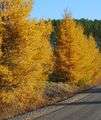 Larix laricina in autumn (Vermont)
Larix laricina in autumn (Vermont)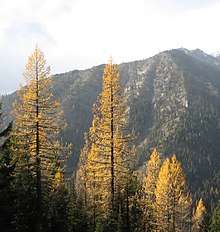 Larix occidentalis (Navaho Ridge)
Larix occidentalis (Navaho Ridge) Male (above) and female (below right) cones of Japanese larch emerging in spring
Male (above) and female (below right) cones of Japanese larch emerging in spring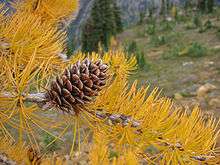 Subalpine larch male fall foliage and cone (strobilus)
Subalpine larch male fall foliage and cone (strobilus)
References
Notes
- Rushforth 1986
- Stace, C. A. (2010). New Flora of the British Isles (Third ed.). Cambridge, U.K.: Cambridge University Press. ISBN 9780521707725.
- Gernandt & Liston 1999
- Semerikov & Lascoux 1999; Wei and Wang 2003, 2004; Gros-Louis et al. 2005
- "The Plant List - species in Larix". London: Royal Botanic Gardens, Kew. 2013.
- European larch canker Natural Resources Canada
- Forestry Commission webpage on Phytophthora ramorum
- On the agricoltural site of Irish government
- "Thousands of Afan Forest trees planted after infected larch". BBC. 21 February 2015. Retrieved 23 February 2015.
- European Standard EN 350-2 (1994); Durability of Wood and Wood-based Products – Natural Durability of Solid Wood: Guide to natural durability and treatability of selected wood species of importance in Europe
- Stutley, Margaret. Shamanism : An Introduction. London: Routledge, 2003. eBook Collection (EBSCOhost). Web. 3 Nov. 2015.
Bibliography
- Gernandt, D. S.; Liston, A. (1999). "Internal transcribed spacer region evolution in Larix and Pseudotsuga (Pinaceae)" (PDF). American Journal of Botany. Botanical Society of America. 86 (5): 711–723. doi:10.2307/2656581. JSTOR 2656581.
- Gros-Louis, M.-C., Bousquet, J., Pâques, L. E., & Isabel, N. (2005). Species-diagnostic markers in Larix spp. based on RAPDs and nuclear, cpDNA, and mtDNA gene sequences, and their phylogenetic implications. Tree Genetics & Genomes 1 (2): 50–63. Abstract.
- Rushforth, Keith (1986) [1980]. Bäume [Pocket Guide to Trees] (in German) (2nd ed.). Bern: Hallwag AG. ISBN 3-444-70130-6.
- Semerikov, V. L., & Lascoux, M. (1999). Genetic relationship among Eurasian and American Larix species based on allozymes. Heredity 83: 62–70.
- Wei, X.-X., & Wang, X.-Q. (2003). "Phylogenetic split of Larix: evidence from paternally inherited cpDNA trnT-trnF region". Plant Systematics and Evolution. 239 (1–2): 67–77. doi:10.1007/s00606-002-0264-3.CS1 maint: multiple names: authors list (link)
- Wei, X.-X., & Wang, X.-Q. (2004). "Recolonization and radiation in Larix (Pinaceae): evidence from nuclear ribosomal DNA paralogues". Molecular Ecology. 13 (10): 3115–3123. doi:10.1111/j.1365-294X.2004.02299.x. PMID 15367124.CS1 maint: multiple names: authors list (link)
Further reading
- Earle, Christopher J., ed. (2011). "Larix (larch) description". The Gymnosperm Database.
- Givnish, Thomas J. (2002). "Adaptive significance of evergreen vs. deciduous leaves: solving the triple paradox" (PDF). Silva Fennica. 36 (3): 703–743. doi:10.14214/sf.535.
The larch paradox—Finally, let us turn to one last, enduring ecological paradox: the deciduous habit of larches (Larix) at high latitudes in nutrient-poor peatlands in the northern hemisphere, where evergreen plants are expected to dominate and often do.
Quote from p. 729. - Phillips, D. H., & Burdekin, D. A. (1992). Diseases of Forest and Ornamental Trees. Macmillan ISBN 0-333-49493-8.
External links
| Wikimedia Commons has media related to Larix. |
- Friedman, William (Ned). "Larch cones in spring." Posts from the Collection, Arnold Arboretum of Harvard University, 2 April 2016. Accessed 26 May 2020.
- Rose, Nancy. "Not All Conifers are Evergreen." Arnold Arboretum of Harvard University website, 6 January 2016. Accessed 26 May 2020.
- "Snow Scenes, winter, larches 1977." Library Featured Images, Arnold Arboretum of Harvard University website, 21 November 2019. Accessed 26 May 2020.
- "Gymnosperm Database - Larix ssp".
- Eichhorn, Markus (August 2011). "The Larch". Test Tube. Brady Haran for the University of Nottingham.
